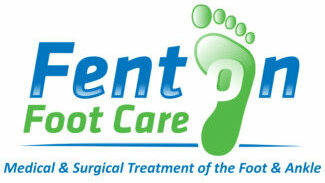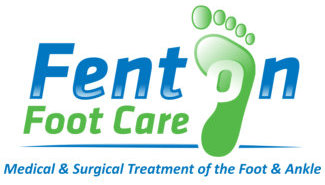Heel pain can occur in the bottom of the heel, but also in the front or the back of the heel. The heel, like any bone, is subject to outside influences that can affect its fitness and integrity. The most common cause of heel pain is abnormalities in the walking gait that put too much stress onto the heel bone and the soft tissue around and attached to it. This stress may also be a result of injury, such as a bruise caused by walking, running, or jumping on a hard surface, or from footwear with a lack of proper support such as flip-flops, or also can result from being overweight.
Some common causes of heel pain include:
- Heel Spurs: A heel spur is a growth of bone on the underside of the heel bone. Visible on x-ray, the spur can extend forward up to a half an inch. Heel spurs can be the result of running and jogging, poorly fitted shoes, worn shoes, walking gait imbalance, or obesity.
- Plantar Fasciitis: Heel pain and heel spurs are often associated with plantar fasciitis, which is a result of the thick ligament [the Plantar Fascia] that runs from the base of the toes to the bottom of the heel being stressed. It is common amongst people who run and jump a lot and can be very painful. The pain can be aggravated by shoes that lack proper support in the arch and by the chronic irritation of an active lifestyle.
- Excessive Pronation: Pronation is the natural flexible motion of the foot’s arch that allows it to act as a shock absorber and adapt to irregular ground surfaces while walking. Excessive pronation can create an abnormally large amount of stretching and pulling on the ligaments and tendons attaching to the heel bone.
- Achilles Tendinitis: Pain at the back of the heel is most often associated with Achilles tendinitis; the inflammation of the Achilles tendon that runs behind the ankle and attaches on the back surface of the heel bone. This condition occurs when the tendon is stressed over time, which causes the fibers to stretch or tear either along the tendon or at the point where it attaches to the heel, leading to pain and inflammation, as well as the possibility of the growth of a bone spur at the back of the heel.
Other possible causes of heel pain include:
- Rheumatoid and other forms of arthritis as well as gout, which usually affects the joint of the big toe
- Bursitis, which is a small irritated sac of fluid
- A Neuroma [nerve growth] or other soft-tissue growth
- Haglund’s deformity, sometimes called a “pump bump”, which is a bone enlargement at the back of the heel bone where the Achilles tendon attaches
- A bone bruise or a contusion, which is the inflammation of the tissue that covers the heel while a bone bruise is an injury caused by the direct impact to the surface of the foot
If pain and symptoms such as inflammation [redness, swelling, heat] persist or limit normal activities, you should call today and schedule an appointment at 810-629-3338 [FEET]. At Fenton Foot Care we offer next-day appointments for most cases. Both Dr. Hirt, Dr. Holdren-Otis and Dr. Castelein will examine the area and possibly perform diagnostic on-site x-rays to rule out any problems with the bone. Early treatment with oral or injected anti-inflammatory medications, proper exercise and shoe recommendations, strapping or taping, or shoe inserts or custom orthotics can effectively treat your heel pain without the need for surgery.
Heel Pain
Heel pain can occur in the bottom of the heel, but also in the front or the back of the heel. The heel, like any bone, is subject to outside influences that can affect its fitness and integrity. The most common cause of heel pain is abnormalities in the walking gait that put too much stress onto the heel bone and the soft tissue around and attached to it. This stress may also be a result of injury, such as a bruise caused by walking, running, or jumping on a hard surface, or from footwear with a lack of proper support such as flip-flops, or also can result from being overweight.
Some common causes of heel pain include:
- Heel Spurs: A heel spur is a growth of bone on the underside of the heel bone. Visible on x-ray, the spur can extend forward up to a half an inch. Heel spurs can be the result of running and jogging, poorly fitted shoes, worn shoes, walking gait imbalance, or obesity.
- Plantar Fasciitis: Heel pain and heel spurs are often associated with plantar fasciitis, which is a result of the thick ligament [the Plantar Fascia] that runs from the base of the toes to the bottom of the heel being stressed. It is common amongst people who run and jump a lot and can be very painful. The pain can be aggravated by shoes that lack proper support in the arch and by the chronic irritation of an active lifestyle.
- Excessive Pronation: Pronation is the natural flexible motion of the foot’s arch that allows it to act as a shock absorber and adapt to irregular ground surfaces while walking. Excessive pronation can create an abnormally large amount of stretching and pulling on the ligaments and tendons attaching to the heel bone.
- Achilles Tendinitis: Pain at the back of the heel is most often associated with Achilles tendinitis; the inflammation of the Achilles tendon that runs behind the ankle and attaches on the back surface of the heel bone. This condition occurs when the tendon is stressed over time, which causes the fibers to stretch or tear either along the tendon or at the point where it attaches to the heel, leading to pain and inflammation, as well as the possibility of the growth of a bone spur at the back of the heel.
Other possible causes of heel pain include:
- Rheumatoid and other forms of arthritis as well as gout, which usually affects the joint of the big toe
- Bursitis, which is a small irritated sac of fluid
- A Neuroma [nerve growth] or other soft-tissue growth
- Haglund’s deformity, sometimes called a “pump bump”, which is a bone enlargement at the back of the heel bone where the Achilles tendon attaches
- A bone bruise or a contusion, which is the inflammation of the tissue that covers the heel while a bone bruise is an injury caused by the direct impact to the surface of the foot
If pain and symptoms such as inflammation [redness, swelling, heat] persist or limit normal activities, you should call today and schedule an appointment at 810-629-3338 [FEET]. At Fenton Foot Care we offer next-day appointments for most cases. Both Dr. Hirt, and Dr. Holdren-Otis will examine the area and possibly perform diagnostic on-site x-rays to rule out any problems with the bone. Early treatment with oral or injected anti-inflammatory medications, proper exercise and shoe recommendations, strapping or taping, or shoe inserts or custom orthotics can effectively treat your heel pain without the need for surgery.


